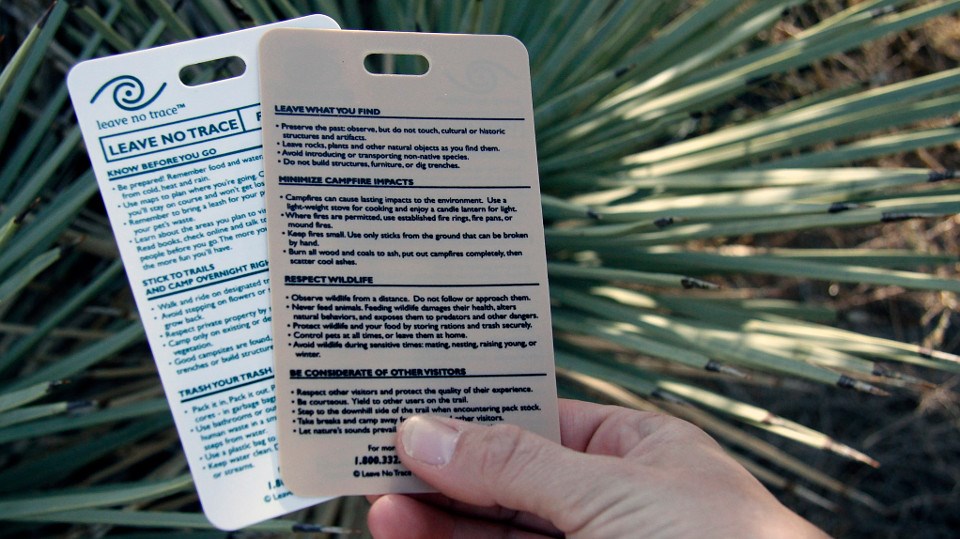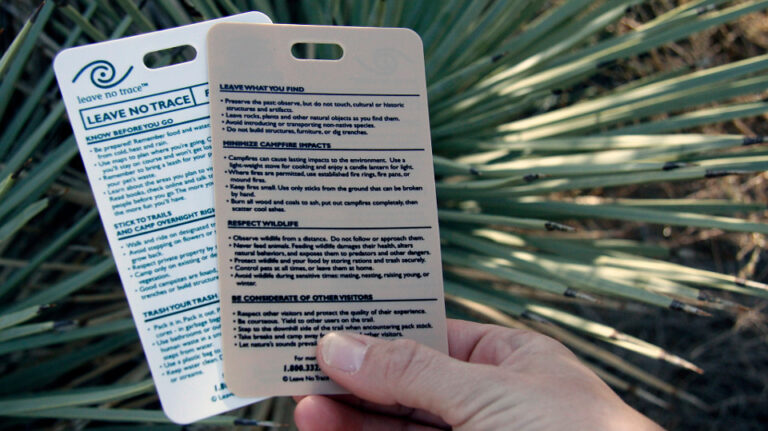
Reference card explains the 7 principles of Leave No Trace
Each of us plays an important role in protecting our national parks. When we spend time outdoors, in the natural world, and in the wilderness, it is important to be conscious of the impact our actions have on plants, animals, other people, and even entire ecosystems. You can minimize these impacts by following the 7 Leave No Trace principles outlined below. It can be applied anytime and anywhere while participating in recreational activities.
Advance Planning and Preparation Understand the regulations and special precautions in the area you will be visiting. Be prepared for extreme weather, danger, and emergencies. Schedule your trip to avoid high usage times. Please visit in small groups whenever possible. Consider splitting large groups into smaller groups. Repackage food to minimize waste. Use a map and compass or GPS to eliminate the use of marking paint, rock cairns, or flags. Traveling and Camping on Durable Surfaces Durable surfaces include groomed trails and designated campsites, rocks, gravel, sand, dry grass, and snow. Protect riparian areas by camping at least 200 feet from lakes and streams. A good campsite is something you find, not something you make. No changes are required to your site. Popular areas: Concentrate on existing trails and campgrounds. Walk single file down the center of the trail, even if it’s wet or muddy. Keep your campsite small. Focus on activities in areas where there is no vegetation. Pristine areas: Spread out use to prevent the creation of campsites and trails. Avoid areas where impact has just begun. Please dispose of waste appropriately. Pack and pack. Check campgrounds, cooking areas, and rest areas for trash and spilled food. Take all garbage, leftover food, and trash home with you. Please use restroom facilities whenever possible. Otherwise, place solid human waste in a cat hole dug 6 to 8 inches deep, at least 200 feet away from water holes, camps, and trails. Once done, cover and hide the cat hole. Pack toilet paper and sanitary products. To wash yourself and dishes, carry water 200 feet away from a river or lake and use a small amount of biodegradable soap. Sprinkle with strained dish water. Leave What You Find Preserve the past: examine and photograph cultural or historical buildings and artifacts, but don’t touch them. If you find rocks, plants, or other natural objects, leave them alone. Please avoid bringing in or transporting exotic species. Do not erect buildings or furniture or dig ditches. Minimizing the Impact of Campfires Campfires can have a lasting impact on the environment. Use a lightweight stove for cooking and enjoy candle lanterns for light. If campfires are permitted, use established firebreaks, fire pans, or mound fires. Please keep the fire small. Use only down from the ground and dead wood that can be crushed by hand. Burn all the wood and coal to ash, completely extinguish the campfire, then spread the cold ash. Respect wildlife Observe wild animals from a distance. Don’t follow or approach them. Never feed animals. Feeding wild animals impairs their health and changes their natural behavior. [habituates them to humans], exposing you to predators and other dangers. Protect wildlife and food by storing food and trash safely. Keep your pet under control at all times or leave it at home. Avoid wildlife during sensitive periods such as mating, nesting, parenting, and winter. Be considerate of other visitors Respect other visitors and protect the quality of their experience. Please be polite. Please yield to other users on the trail. Once you encounter a herd, continue on the downhill side of the trail. Take a break and camp away from the trail and other visitors. Cherish the sounds of nature. Avoid loud voices and noise.
These principles were established by the No-Leave Center for Outdoor Ethics and built on efforts by the U.S. Forest Service, National Park Service, and Bureau of Land Management in the mid-1980s. This relationship continues today. The principles are based on and informed by scientific research in the fields of recreational ecology and human aspects of natural resources. Learn the science behind the principles on the Leave No Trace website.
Thank you for your commitment to protecting our natural world.
“Seven Leave No Trace Principles” © 1999, Leave No Trace Center for Outdoor Ethics: www.LNT.org.

